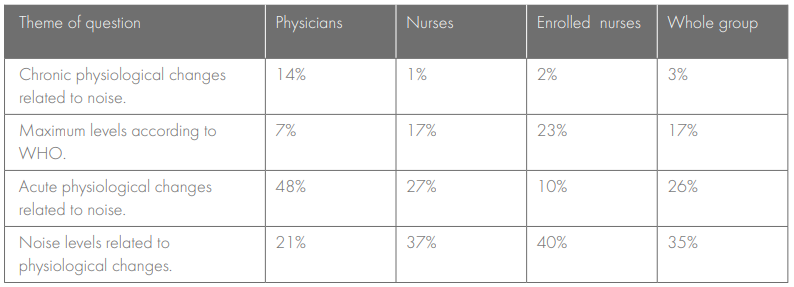
Soundproofist
Soundproofist is a great blog and podcast universe about noise and acoustics issues driven by Cary Norsworthy and on the website, she states that
”Noise is a power struggle. Noise creates conflict. Conversely, acoustics is an art. And learning what makes acoustics sound great is a skill that each of us can learn.”
– and the podcast episodes on sound and noise cover a lot of areas within the field. (Read more about Soundproofist here).
Podcast on healthcare noise – some research before you listen.
In this particular episode, the topic is healthcare noise. Listen to the Soundproofist episode here.
Research
In 2016, a group of Swedish researchers revealed that staff members in a select group of hospitals knew little about the impact of sound and noise in healthcare. Particularly how sound affects patients or even themselves[1].
Questionnaires were handed out to 1,047 staff members at nine ICUs and none of the respondents answered all ten questions correctly. The average number of correct answers was just four. The question with the lowest proportion of correct answers (just 3%) related to which chronic physiological changes can be linked to noise.

Research shows that hospitals particularly struggle with noise and that chronic physiological changes are linked to a bad sound environment. But since the 1960s, sound and noise in healthcare facilities have been increasing dramatically, both during the day and at night[2]. As the table below shows, we are straying far above the levels recommended by the World Health Organisation.

Today, hospitals are complex ‘cities’ with a lot of people, a lot of technical equipment, and more and more advanced challenges to solve. This might also be the reason why medical staff doesn’t know exactly how sound affects people; their task is to save lives.
The outcome of bad acoustics
But patients suffer because of sound and noise in healthcare facilities. In short, noise makes it difficult for patients to sleep and rest, and the negative impact can be seen in medication intake[3], hospital readmissions[4], and e.g. heart rates [5]. During acute illness, a bad acoustics environment may have important detrimental physiological effects on rehabilitation[6].
‘Unnecessary noise is the cruelest absence of care which can be inflicted upon either the sick or well!’
Florence Nightingale in Notes on Nursing, 1859
_____________________________________________
[1] Johansson L, et al.: ‘’Noise in the ICU patient room – staff knowledge and clinical improvements’’. Intensive and Critical Care Nursing (2016).
[2] Busch-Vishniac et al., “Noise Levels in John Hopkins Hospital”, Journal of the Acoustical Society of America, Dec 2005, 118(6), p3629-3645
[3] Hagerman et al: “Influence of intensive coronary care acoustics on the quality of care and physiological state of patients”, International Journal of Cardiology, Volume 98, Issue 2, February 2005
[4] Ibid
[5] Weise, “Investigation of patient perception of hospital noise and sound level measurements: before, during and after renovations of a hospital wing”, Architectural engineering – Dissertations and Student Research, 2010, Paper 4, p7
[6] Hagerman et al: “Influence of intensive coronary care acoustics on the quality of care and physiological state of patients”, International Journal of Cardiology, Volume 98, Issue 2, February 2005

